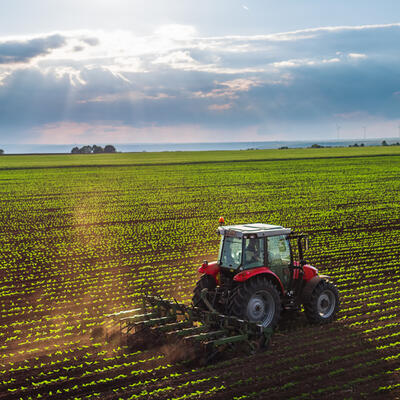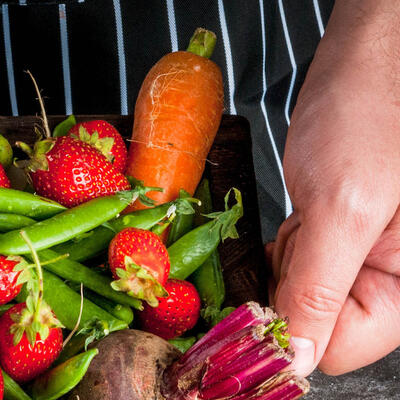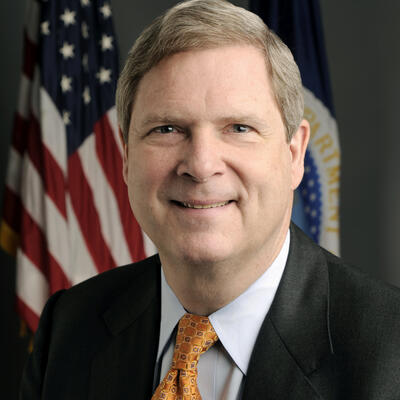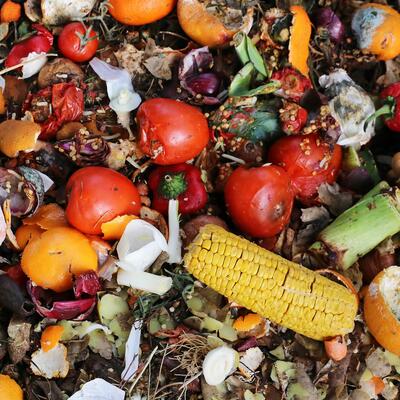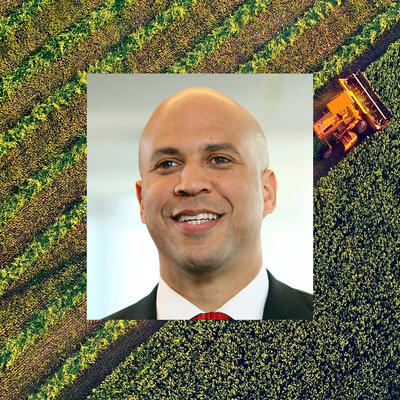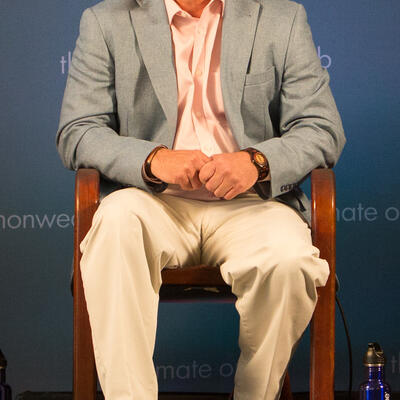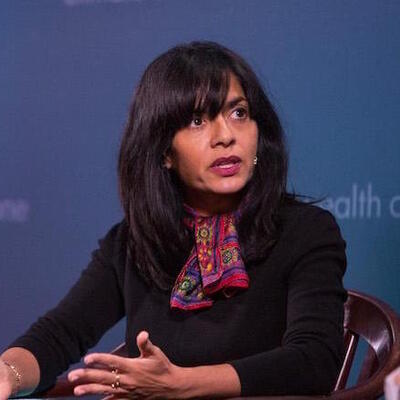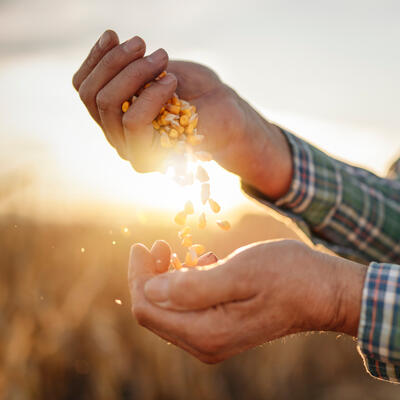
Climate Smart Agriculture with Secretary Tom Vilsack
Guests
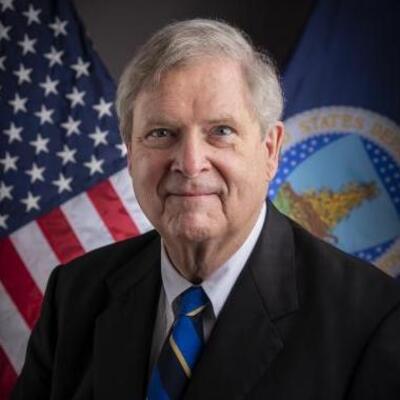
Tom Vilsack

Anthony Myint

Jeremy Martin
Summary
From tilling soil to fertilizer use to belching and farting cows, agriculture is a major climate polluter, responsible for around 11 percent of U.S. emissions. Conventional farming aims to maximize crop production using practices that contribute carbon to the atmosphere.
“For 60 years, the message that's been conveyed to farmers across the United States has been, you've gotta produce more. You've gotta produce more,” says Tom Vilsack, U.S. Secretary of Agriculture, a role he also held for eight years under President Barack Obama.
But by using tools like cover crops, compost and rotational grazing, soil also holds the potential for massive carbon sequestration, which is good for the climate, crops and farmers. For years, the government has incentivized environmental best practices through federal programs that address things like habitat, watershed health and erosion. But the Biden administration has put more money and support into those efforts with a climate lens. In 2022, the USDA launched a Climate-Smart Commodities program, investing more than $3 billion into 141 projects, including many small and underserved producers.
“That's one of the principal reasons for doing climate smart practices: not just to reduce greenhouse gas emissions or to sequester more carbon, but to improve soil health. And as we improve soil health, we're also going to improve productivity,” Vilsack says.
Despite domestic and international pressure for climate action, Secretary Vilsack says the voluntary nature of these programs is better than regulations.
“When you try to regulate farming operations, what you do is you essentially invite a series of lawsuits, a set of efforts to delay the implementation of a particular regulation. We're gonna get much further, much faster, listening to farmers who basically said, ‘if you create a voluntary system, which is incentive based and market-based, we will respond.’”
And there are other incentive models out there to encourage farmers to change their practices for climate reasons. As Executive Director of Zero Foodprint, Anthony Myint works to support healthy soil as a climate solution by organizing restaurants and businesses to add a small surcharge on meals and food. These funds are collected and distributed to participating farmers to pay them to implement things like cover cropping, compost and other climate smart practices. Myint says the amount each consumer contributes is small, but can have a big impact.
“One percent actually adds up to quite a lot. At the society level, 1% of GDP would generate a trillion dollars a year towards climate solutions. And according to Project Drawdown, that $1 trillion a year between now and 2050 would actually be enough to lower global temperatures,” he says.
Highlights:
2:25 Secretary Tom Vilsack on methane reduction
6:20 Tom Vilsack on Climate-Smart Commodities and voluntary incentives
13:13 Tom Vilsack on using less fossil-based fertilizers
17:30 Tom Vilsack on working collaboratively with tribes for forest stewardship
20:00 Tom Vilsack on addressing USDA’s history of racial discrimination
27:30 Jeremy Martin on corn ethanol versus gasoline
31:20 Jeremy Martin on updates to renewable fuel standard
40:00 Anthony Myint on current agricultural subsidies and incentives
43:20 Anthony Myint on Zero Foodprint’s mission and work
Related Links:
Zero Foodprint
USDA Climate-Smart Commodities
Digging Deep into the Next Farm Bill
Episode Highlights
2:25 Secretary Tom Vilsack on methane reduction
6:20 Tom Vilsack on Climate-Smart Commodities and voluntary incentives
13:13 Tom Vilsack on using less fossil-based fertilizers
17:30 Tom Vilsack on working collaboratively with tribes for forest stewardship
20:00 Tom Vilsack on addressing USDA’s history of racial discrimination
27:30 Jeremy Martin on corn ethanol versus gasoline
31:20 Jeremy Martin on updates to renewable fuel standard
40:00 Anthony Myint on current agricultural subsidies and incentives
43:20 Anthony Myint on Zero Foodprint’s mission and work
Resources From This Episode (2)
Full Transcript
Note: Transcripts are generated using a combination of automated software and human transcribers, and may contain errors. Please check the actual audio before quoting it.
Greg Dalton: This is Climate One. I’m Greg Dalton. Agriculture is responsible for around 11 percent of U.S. emissions. Conventional farming aims to maximize crop production using practices that contribute carbon to the atmosphere.
Tom Vilsack: For 60 years, the message that's been conveyed to farmers across the United States has been, you've gotta produce more. You've gotta produce more.
Greg Dalton: And yet by using tools like cover crops and compost, soil ALSO holds the potential for massive carbon sequestration, which is good for the climate and farmers.
Tom Vilsack: That's one of the principle reasons for doing climate smart practices, not just to reduce greenhouse gas emissions or to sequester more carbon, but to improve soil health.
Greg Dalton: So how do we change the practices on the ground and get more farmers using these tools?
Tom Vilsack: We're gonna get much further, much faster, listening to farmers who basically said, if you create a voluntary system, which is incentive based and market-based, we will respond.
Greg Dalton: Climate Smart Agriculture with Secretary Tom Vilsack. Up next on Climate One.
Greg Dalton: This is Climate One, I’m Greg Dalton.
Ariana: And I’m Ariana Brocious.
Greg Dalton: When we think of climate-harming emissions we often think of smokestacks, powerplants, and car tailpipes. But agriculture is a huge part of our total carbon footprint.
Ariana Brocious: From tilling soil to fertilizer use to belching and farting cows, agriculture is a major carbon emitter. For years, the government has incentivized environmental best practices through federal programs that address things like habitat, watershed health and erosion.
Greg Dalton: Now the Biden administration has put more money and support into those efforts with a climate lens.
Ariana Brocious: Tom Vilsack is U.S. Secretary of Agriculture, a role he previously held for eight years under President Barack Obama. In 2022, his agency, the USDA, launched a Climate-Smart Commodities program. The USDA is investing more than $3 billion into 141 projects, including many small and underserved producers.
Greg Dalton: We’ll get into the climate smart ag in a moment. I began my conversation with Tom Vilsack by asking about the Global Methane pledge, which was signed by 150 countries and aims to cut emissions from dairy 30% by 2030. California is aiming to cut methane emissions 40 percent in the same period, prompting me to suggest the US plan lacks ambition. Secretary Vilsack disagrees.
Tom Vilsack: The fact is there are nine separate dairy projects associated with our climate Smart Agriculture and Forestry Commodity Partnership Initiative, which are looking at a variety of processes for reducing methane, capturing methane and converting methane from dairy production. And I think those programs will provide us a very clear pathway for both large and small dairies to basically embrace climate smart practices, which will lead over time to methane reduction. In addition to that, the Inflation Reduction Act contains additional resources to decarbonize our utility grid in rural communities. And I suspect strongly that you're gonna see an increase with that funding and the renewable energy for America program funding under the IRA in digesters. So I think there's a lot of activity that may not be on the surface, or may not be as prevalent as one company's commitment. But I think the industry here in the US is committed to getting to net zero by 2050 and is working towards that goal.
Greg Dalton: The dairy digesters that you mentioned turn waste into electricity. That requires some real scale to make that investment. And some people are concerned that that hurts local air quality, local pollution. It helps globally and creates electricity. But people who live near large industrial beef and dairy operations, does that come in conflict with some of your priorities about helping traditionally marginalized communities?
Tom Vilsack: No, I don't think so because part of what we're working on through the climate smart commodities effort is a separation technology in which we are separating the solids and the liquids, reclaiming the liquids so that we have better utilization of our scarce water resources and taking the solids and basically pelletizing those solids, which I think will eliminate a lot of the concerns that folks have. And I think ultimately this is a technology that as we utilize it will significantly reduce many of the challenges that the livestock industry has faced relative to waste. In addition, these digesters not only take a focus on animal waste, but they also are a good source for food waste, which can eliminate the utilization of and placement of food waste in landfills, which is a very significant methane producer. So I think there are a number of technologies that are gonna lead us to a much better place for our livestock industry, for farm income, for the quality of life in rural communities and for us as a country, providing leadership in terms of climate change.
Greg Dalton: The partnership for climate smart commodities uses incentives to encourage farms, ranches, orchards, and forests to clean up their operations. What do you say to people who say that incremental voluntary approaches by industry won't be enough or fast enough to slow rising climate disruption and meet the Paris goals?
Tom Vilsack: Well, I would say that they need to understand what works in the countryside. I can tell you that if you understand the economics of farming, it can be incredibly challenging. And when you try to regulate farming operations, what you do is you essentially invite a series of lawsuits, a set of efforts to delay the implementation of a particular regulation. We're gonna get much further, much faster, in terms of climate smart practices by listening to farmers who basically said, if you create a voluntary system, which is incentive-based and market-based, and you create an opportunity for us to have a value-added proposition in the marketplace, we will respond. And the proof of that is in addition to the 141 projects that we actually funded, there were roughly 850 other projects that were proposed that we couldn't fund because of limitation of funding. So there's tremendous interest out there in the countryside. The Inflation Reduction Act, and to a certain extent the infrastructure law, provide additional resources that will complement the Climate Smart Partnership effort. So I'm confident we're gonna see significant progress and there's a factor of this program that people often don't focus on, which is there's a measurement, verification, monitoring, and reporting requirement associated with these projects. So we're gonna know what works and what doesn't work, and we'll be able to funnel and target resources in the future to promote what does work.
Greg Dalton: And you mentioned those 140 some odd programs. USDA programs often favor industrial companies that have capital and resources to make the transition and it takes money to get money out of the federal government. You talked recently at Tuskegee University in Alabama about helping small and historically marginalized landowners transition to climate smart practices. So what is being done to help small scale farmers, ranchers make this transition that involves investment and learning new ways of doing things?
Tom Vilsack: Well, there are a couple answers and responses to that question. First of all, the structure of the Climate Smart Partnership Initiative recognized the importance of making sure that we were able to provide smaller grants to smaller farming operations, to underserved operators. And so a number of the projects within that 141 are in fact focused on small-sized operations, mid-sized operations, historically underserved producers. And the partnerships that we've formed with universities, with environmental groups, with conservation groups, food companies, with retailers, are providing additional support above and beyond what the federal government is providing, leveraging roughly 50% of additional investment. So that's one aspect. The other aspect is working with those producers to make sure that they take full advantage of the regular conservation programs that are offered. We know that it sometimes can be difficult for underserved producers to be able to access these programs. So we've entered into a number of contracts with cooperative groups, groups that have a trusted relationship with small and mid-sized operators to provide them resources to be able to expand our outreach and to provide technical assistance to those producers so they can qualify more easily for the normal conservation programs. And then, it's great that you do conservation. It's great that you are encouraging climate smart practices, but you want those folks to be able to stay in business and so it's necessary for us to develop a local and regional food system with market opportunity for those underserved producers, for those minority producers, for those small sized operators. So we are using federal procurement resources to help create that local and regional food system. We're creating resources to be able to address food deserts, particularly in areas, rural areas where local and regional food producers might be able to provide assistance. We're expanding farm to school and farm to institution programs, all designed to create market opportunities. And then as we do business with many of these producers and they go through a tough stretch as producers often do, now we are changing our attitude and our approach to debt servicing instead of focusing on trying to figure out how to collect the debt. We're in a position now where we're providing some debt forgiveness, and we're also developing a new structure to work with these producers to make it a little bit easier for them to stay on the land.
Greg Dalton: I'd like to ask about practices that are fairly well established on the margins of our industrial agricultural system in this country, and could bring climate benefits if more widely adopted. I’m talking about cover crops, regenerative agro forestry, no-till farming. We've heard from other ag experts that federal environmental incentive programs are way oversubscribed. There's more interest among farmers than there is money to give to them. So what are you doing to change that?
Tom Vilsack: Well, that was true before the passage of the Inflation Reduction Act. But as a result of the passage of that, we now see an historic investment that's being made by the Biden administration and by Congress in those very programs that as you said, were oversubscribed. The challenge will be for us to make sure that we also have the personnel and to provide the technical assistance necessary to make sure that folks take full advantage of those increased finances and financial assistance. So I think we're gonna see a tremendous expansion of interest and use of those traditional conservation programs. And we know that there are roughly 45 different practices, you mentioned several, that we are going to try to steer or target or focus the resources under the Inflation Reduction Act to be, to better encourage rotational grazing, to better encourage regenerative practices, cover crops. We also have looked at ways in which we can encourage through risk management tools through crop insurance premiums if you will, or incentives to encourage more cover crop activity, and also trying to find markets for that.
Greg Dalton: I talk to climate people of course across a range of sectors and some of the biggest optimists I talk to are the soil people who, you know, soil is sexy now and, and soil can sequester water and carbon. So speak specifically to, to soil cuz it's often urban people think soil and dirt's the same thing.
Tom Vilsack: Oh no. You know, I think it's important for people to understand that every single acre of ground, even an 80 acre, 160 acre, 640 acre farm is different. It's sort of like kids. Every acre's different. You have to understand the characteristics of every acre. Some acres need more nutrition, some acres need less, and that's why we're investing in precision agriculture, why we're making sure that as farmers are utilizing inputs that they're doing, it is in the most efficient and effective way possible. And we're making sure that those tools are not just available to commercial sized operators, but understanding the challenges that some of those small and mid-sized operators have.
We're also trying to make sure that they can take full advantage of reduced costs associated with precision agriculture. Now, we also understand and appreciate that as we do more climate smart practices, the expectation is that the productivity of soil is going to increase, it's gonna get richer, it's gonna get better, it's gonna get healthier. That's one of the principle reasons for doing climate smart practices, not just to reduce greenhouse gas emissions or to sequester more carbon, but to improve soil health. And as we improve soil health, we're also going to improve productivity. So there's multiple benefits, if you will, from Climate Smart Practices.
Greg Dalton: So does that mean less pounding it with fossil fuel-based fertilizers?
Tom Vilsack: Well, we're looking at a variety of ways in which we can look at alternatives and substitutes. We obviously know that the cost of fertilizer today is expensive, in large part because of Russia's unprovoked and ill-advised war in Ukraine. And the president has instructed us to utilize roughly a half a billion dollars to try to figure out ways in which we can be more self-reliant when it comes to fertilizer in terms of substitutes, in terms of more efficient use of fertilizer. But you know, what we're learning from our research and an understanding of precision agriculture is that some acres of ground that are currently being fertilized don't really require fertilizer at all. Or require a significantly reduced amount. So, in fact, I talked to one group of scientists at Iowa State University who suggested that maybe in the Midwest, perhaps as much as 30% of the corn acres that are currently utilizing fertilizer may not need much, if any, uh, fertilizer. That would be an enormous savings and an enormous opportunity to have a more efficient, more effective, a more soil-health focused agriculture. And this is an incredibly transformational time in American agriculture. I think there's an understanding and appreciation that for 60 years, the message that's been conveyed to farmers across the United States has been, you've gotta produce more. You've gotta produce more. And American farmers responded. American consumers have had an incredibly wide array of choice as a result. The challenge, however, is that not only have we seen some concerns about soil health, but we've also seen a growing disparity in terms of income opportunities for those who were able to get larger over time and those who decided or, or had to remain small or midsize. So our challenge, I think, is to move away from that singular model of focusing on production and looking at ways in which we can not only be product productive, but also profitable, sustainable, and resilient. And that requires, I think, a commitment to local and regional food systems. It requires a commitment to climate smart agriculture. It requires an expansion of processing capacity so there's more competition. It requires greater assistance from the government to embrace more value-added propositions, whether it's climate smart commodities, or whether it's organic. All of that is actually being done now at USDA as a result of the American Rescue Plan resources, the infrastructure law, and the Inflation Reduction Act.
Greg Dalton: You’re listening to a Climate One conversation with US Agriculture Secretary Tom Vilsack. Please help us get people talking more about climate by giving us a rating or review. You can do it right now on your device. You can also help by sending a link to this episode to a friend. By sharing you can help people have their own deeper climate conversations. Coming up, how the US Department of Agriculture is trying to move beyond decades of bias and discrimination against farmers of color and women:
Tom Vilsack: We are learning that we have to really think carefully about how to infuse into USDA, an understanding of the power and the benefit of diversity, equity, inclusion, and accessibility. The president is very, very focused on this and is expecting us to deliver on that promise.
Greg Dalton: That’s up next, when Climate One continues.
Greg Dalton: This is Climate One. I’m Greg Dalton. Let’s get back to my conversation with Tom Vilsack, US Secretary of Agriculture. The agency he leads, the USDA, controls vast tracts of forest in the American West that have been scorched by horrific wildfires in recent years. The Forest Service Climate Adaptation Plan says its ability to adapt to climate change depends on building trust and developing strong collaborations with tribal nations and other indigenous peoples. I asked Vilsack what he’s personally doing to build that trust and overcome centuries of settler colonialism.
Tom Vilsack: Well, I think one answer to that question is basically encouraging the forest service to do what it has wanted to do for some time, which is to work collaboratively with tribes in a co-stewardship. The fact is tribes understand forest health as well as anybody. They've obviously lived in those forests. They have depended on those forests for many, many, many, many years, if not centuries. And so they understand and appreciate the importance of forest health. So working in co- stewardship and co-management, that is to say working collaboratively, in a consultive way with tribes as we look at ways in which we can improve forest. We've got a crisis on our hand, no question about it. That's why we have a wildfire crisis strategy. We just recently announced an additional 11 priority landscapes where we're investing between those landscapes and the 10 that we announced last year, roughly 930 million in helping to provide treatment in those forests in a thoughtful way to reduce the risk of catastrophic wildfire. To create opportunities for healthier forests. And from that obviously come a wide variety of benefits, not the least of which is we're not seeing carbon go up into the atmosphere. We're seeing more recreational opportunities and we're seeing a better relationship with tribes and others, frankly, as we work. We listened to folks. We went out before we decided on these 11 landscapes in the 10 previous landscapes. We listened to folks in those areas and said, what do you think we need to do? What do you think we need to focus on? Where do we, where do you think the need is greatest? And by listening, we've been able to identify these priority landscapes, and the result is about 134 of the most seriously at-risk landscapes are gonna be treated, if you will, as a result of these resources, uh, which hopefully over time will reduce the risk of catastrophic wildfire.
Greg Dalton: During America's racial reckoning in the last three years, I've learned a lot about how systemic racism has shaped this country and frankly benefited me as white man. You and I have sort of wind in our back every time we walk into a situation, and I'm ashamed how inadequate my fancy private education was, and I've learned that I need to own some of my own ignorance and not lay that at the feet of others. What's been your journey in the last few years? What do you see now about race in America that you didn't see the first time you were in this position?
Tom Vilsack: Well, I'm not gonna say that I didn't see it the first time I was in this position because I spent a lot of time, uh, working to try to resolve literally thousands of claims against the Department of Agriculture for discrimination that was experienced by African American farmers, Hispanic farmers, women farmers, native American farmers. And as a result of the work of the Obama administration, we were able to resolve and at least provide some level of justice to over 20,000 of those producers. And we did have a process in which we began the process of trying to make sure that USDA embraced diversity as opposed to being opposed to it. That work continues now in the Biden administration at an accelerated level. I mentioned the debt servicing. That's a good example of work that we're doing with distressed farmers, many of whom are minority producers, basically changing the way in which we think about the relationship between us and those farmers in terms of when times are tough. I mentioned the fact that we are looking for ways in which small and mid-size producers can access additional markets and additional support from the government. We also established an equity commission, Which the Deputy Secretary and Arturo Rodriguez, former president of the United Farm Workers, are co-leading. And this equity commission is basically taking a look at the way in which we've done business in the past to try to identify places where there may be systemic issues that have created barriers, created difficulty, made it more difficult for folks to access the programs at USDA. And I think we're learning a lot from that. We are learning that we have to really think carefully about how to infuse into USDA, an understanding of the power and the benefit of diversity, equity, inclusion, and accessibility. The president is very, very focused on this and is expecting us to deliver on that promise. And we're taking a look at many of our programs. Give you a couple additional examples. We are focused on rural development. And the need for us to basically identify areas where there has been persistent poverty for far too long. And by persistent poverty, I'm talking about poverty rates that have exceeded 20% for 10, 15, 20, 30 years. We have established a program called the Rural Partnership Network, where we are essentially going into states where there are areas of persistent poverty and we're identifying several communities, maybe two, maybe three or four communities where this has been the case for quite some time, we've assembled a staff that will be physically located in those communities, who will work on behalf of USDA. And connect those communities to every single federal agency that does work domestically. So as these communities identify key programs and projects that are of most interest to them, to basically take the next step to get themselves in a better position, we're gonna be able to help provide the guidance, the technical assistance, the assurance of success, if you will, as they work with the federal government. Sometimes can be somewhat of a daunting activity for, especially for communities that are persistently poor. By no means do we have all the answers, but there is an aggressive effort being made.
Greg Dalton: EV sales are surging in this country and around the world. Batteries are winning the technology race over hydrogen and other alternatives to petroleum. If the federal government and California continue to subsidize biofuels made from soy and corn, as a former governor of Iowa, you’re known as a fan of blending corn with gasoline. A study last year funded in part by the US Department of Energy found that corn ethanol is likely at least 24% more carbon intensive than gasoline due to emissions resulting from land use changes to grow corn along with processing and combustion. Should the US reconsider its support for corn ethanol given that the market is clearly choosing electric vehicles with batteries?
Tom Vilsack: Well, first of all there are a number of studies that I could provide to you that would suggest that what you've suggested about biofuels is not actually environmentally correct. When you took a look at air quality, when you take a look at the increased productivity of corn production, what you'll find, I think is at the end of the day, it is significantly better to have biofuel mixed into your fuel than to basically rely on purely fossil fuels from the environment. So that's number one. Number two, you know, the reality is that as much discussion as there's been about electric vehicles the reality is that it’s going to take a considerable period of time before our vehicle fleet is totally electric. Some have suggested it may be another 20, 30 years before that happens. So in the meantime, do you want cleaner air? Do you want a fuel with lower carbon intensity? It seems to me that you do want to have that kind of fuel. And then finally, you know, it's one thing to talk about putting a battery in a car. It's another thing to put that battery in an airplane. And so that's why the aviation industry is making a concerted effort to encourage us to support an acceleration of sustainable aviation fuel, lower carbon biofuel that will fuel our planes and our ships to reduce the greenhouse gas input of that transportation system. And we are very much interested in working with the Department of Energy and the Department of Transportation to accelerate that. We've set as a goal a grand challenge of producing 3 billion gallons of that sustainable aviation fuel. So the reality here is that it's not just, it's not just fuel. There's an entire bioeconomy that can help us transition from a fossil fuel-based economy to one that is more bio-based. And as we do that, we a) produce more income for farmers. B), environmentally better products for consumers, and c) create better manufacturing jobs in rural places, all of which is, I think, very consistent with the president's design to rebuild and restructure the economy of this country from the bottom up and the middle out to strengthen the middle class. You've gotta do that in, in rural places. To do that, you've gotta bring manufacturing back and I will tell you that we are looking at ways in which you can use agricultural waste in a million different ways to produce those products. So it's an exciting future ahead of us.
Greg Dalton: And, and forest and wood and timber from forest so it doesn't burn. Yeah.
Tom Vilsack: Woody biomass basically helps to reduce that hazardous fuel buildup, which in turn reduces the risk of catastrophic fires. So a lot of benefits I think from what we're trying to do at USDA and we're excited about.
Greg Dalton: Tom Vilsack, secretary of the US Department of Agriculture. Thanks for coming on Climate One.
Tom Vilsack: Thank you.
Greg Dalton: As we just heard, Secretary Tom Vilsack justifies ethanol by saying it burns cleaner than gasoline. But I wanted to know about the full lifecycle analysis of corn ethanol and the climate impacts of biofuels if you include land use, water use, cutting forest to grow more soy. So I spoke with Jeremy Martin, senior scientist with the Union of Concerned Scientists’ Clean Transportation Program.
Jeremy Martin: Yeah, so there've been a lot of analyses of that question over the last 10 years, and they haven't reached a firm consensus. I think in some respects it's not the right question because nobody's really reconsidered the ethanol that's already blended with gasoline. Right? That decision was made. That's really part of the system now. Is corn ethanol better or worse than gasoline? My inclination is that yes, it is better than gasoline. It's cleaner today than it was 10 years ago. And there's a lot of ways it could get cleaner over time. But that's not the whole story. I mean, a lot of these scientific debates have been around what was the impact of land use change, and I think that informs how much corn should we use for fuel? How much vegetable oil can we use for fuel? How much of these other resources can we use for fuel? So getting the right answer to how much is different than, is it better or worse than gasoline? Because ultimately, we need to get to zero. So being a little better than gasoline's, not the right metric over the long term. So the way that I think about it is, what's the consequence of dramatically increasing biofuel use as we did shortly after the renewable fuel standard was passed, especially in the period between 2005 and 2010. Of course people have slightly different interpretation of it, but the lesson I take away is, you know, we shouldn't repeat that again. We shouldn't have a huge increase in biofuel production in a short period of time. that's gonna have ripple effects in the agricultural system, which could be damaging,
Greg Dalton: Right. And during that time of 2005 to 2010, there was a lot of debate and concern about food versus fuel.
Jeremy Martin: Yeah. Well, so we saw a big expansion, very rapidly of the use of corn for ethanol, which went from, you know, before 2005 it was a fairly minor use of corn, and by the time we got to 2010, it was something like a third of the corn was being sent to ethanol plants and was one of the biggest users of corn together with animal feed. And that sudden shift was quite disruptive. What's interesting to me today, is that's happening again, but not with corn. Actually corn use for ethanol has been fairly stable over the last decade now. It's actually soybean oil, which is suddenly expanding as oil refineries retrofit to process renewable diesel from soybean oil. And this is happening again in a period where food prices are high. And, and in particular, vegetable oil prices are high on the global market for a variety of reasons, not all related to biofuels, but it definitely begs the question of, you know, have we learned the lesson of 2005 and can we translate a lesson about corn to the other important global commodity crops of soybeans and vegetable oil?
Greg Dalton: And also when you mentioned soy, I think of deforesting the Amazon to grow soy to go into gas tanks and into, into feed cows. What about that part of the equation?
Jeremy Martin: Yeah, I mean, there are a lot of reasons to be worried about a big increase in the use of vegetable oil for fuels. The US is a big producer of soybeans. So what's likely to happen is, you know, more of the crop that's produced in the US will be used domestically and not exported. And then those exports that we used to send will be made up for in other places, for example from South America, or that soybean oil will be replaced with palm oil from Southeast Asia. So, yeah, there's a lot of reasons to think that's not really a great strategy to reduce US gasoline and diesel consumption. And so we should be smart about how much vegetable oil, how much corn, you know, makes sense to direct into the fuel use.
Greg Dalton: So the renewable fuel standard was created nearly 20 years ago, shortly after General Motors famously killed its first electric car. There were no EVs on the market. Today there are many, and the renewable fuel standard is up for revision or extension. What are the points of tension around updating the renewable fuel standard?
Jeremy Martin: So when the renewable fuel standard was passed and then amended in 2007, Congress set targets out through 2022. And so now it's up to EPA to set the targets going forward. And one of the big problems with the federal renewable fuel standard is that it's all about combustion fuels and really doesn't actually recognize renewable electricity and wind and solar as renewable sources of transportation fuel. So that's a huge problem. And it's a problem, you know, in the way that the law was written and can only be fixed by Congress. So, EPA’s they're setting a course, trying to adapt the standard to the current context. But it's difficult because they have to follow what's in the law.
Greg Dalton: So, what is the demand for biofuels as EVs take off? Will we wind down our use of corn or soy for cars?
Jeremy Martin: I think certainly corn ethanol for blending with gasoline is intimately linked to the amount of gasoline we use. And so as we use more electric vehicles and less gasoline, we'll see less corn ethanol being blended with gasoline. We're expecting gasoline use to fall most quickly. So, diesel fuels, which is where most of the vegetable oil-based fuels go, may take a little bit longer. But even as we look out a couple decades, you know, I think biofuels will continue to have an important role but that role will evolve. So today where most of the biofuels are blended into gasoline, you know, I think we'd anticipate 20 or 30 years from now seeing most of the biofuels for aviation fuel. And so the way that we produce biofuels to change, to get cleaner and to stop taking this benchmark of a little cleaner than gasoline as the standard. But really say like, how do we produce biofuels that are headed towards zero emissions? And how do we do it in a way that's, and at a level that's reasonable considering all the other uses of crops and of land.
Greg Dalton: Is there a lifecycle analysis of crop land for sustainable aviation fuels? And is that different than biofuels for cars?
Jeremy Martin: Yeah, and this is where it gets a little tricky because the lifecycle analysis depends a lot on what the fuel is made out of. So, today most of the biofuel blended with gasoline is corn ethanol, and most of the biofuel blended with diesel fuels are various kinds of biodiesel and renewable diesel. And the largest source of those is soybean oil. But over time, new processes, new things are coming online. And so we don't know if aviation fuel in the future is made from lipids, different kinds of fats and oils or their process to make corn into aviation fuel. And of course, ever since 2007, people have been working on how to make cellulosic fuels using agricultural residues and other kinds of materials to make biofuels. And there's not enough vegetable oil to just make a lot of sustainable aviation fuel from vegetable oil. So we really need to bring these other types of materials into that market.
Greg Dalton: What changes would you personally like to see made to the renewable fuel standard?
Jeremy Martin: Yeah. The most important change in a way is to recognize that solar energy and wind power, these are really important renewable resources, and especially as we look up to a transportation system powered mostly by electricity, we need to have a fuel policy that recognizes the central role of renewable electricity and transportation electrification.
Greg Dalton: Jeremy Martin is a senior scientist with a Union of Concerned Scientists Clean Transportation Program. Jeremy, thanks for sharing your insights with us today.
Jeremy Martin: Yeah, my pleasure. Thank you for the opportunity.
Greg Dalton: You're listening to a conversation about how changes to agriculture can cut climate emissions. This is Climate One. Coming up, a chef and restaurateur trying to encourage better climate practices on farms:
Anthony Myint: You've got great chefs supporting great farms, but I don't know any chefs or restaurateurs or you know, anybody who is like at the farmer's market saying to the good farmer or the conventional farmer, hey, let me pay an extra dollar and maybe you could use this to plant some cover crops or apply some compost instead of fertilizer.
Greg Dalton: That’s up next, when Climate One continues.
Greg Dalton: This is Climate One. I’m Greg Dalton. We’re talking about the power of agricultural practices to sequester carbon and be more climate friendly. As Executive Director of Zero Foodprint, Anthony Myint works to mobilize the restaurant industry and others to support healthy soil as a climate solution. He spoke with Ariana Brocious about those efforts and his personal journey.
Ariana Brocious: You're an accomplished chef and restaurateur in San Francisco. Tell us about your experience trying to change the food system and support regenerative practices through your restaurant.
Anthony Myint: So we first learned about regenerative agriculture in 2014 and 2015, and got really excited about it and started a restaurant called The Perennial, where we were showcasing a perennial grain called Kernza under development by the Land Institute in Kansas as well as climate beneficial beef. And so they were managing the way cattle grazed as well as applying compost to the field to expedite carbon sequestration. So we were showcasing these kinds of ingredients and trying to get consumers excited about it. And then after a couple years, we started to feel like maybe it wasn't having the biggest impact in the field.
Ariana Brocious: So why did you feel that way? I mean, you were offering these products that you were contracting, so you as a supplier were in relationship, you had some buying power, but was it just insufficient?
Anthony Myint: You know, I think the actual crystallizing moment for me was being at a happy hour with a soil scientist. And I kind of had given my rah rah regenerative a type of speech. And then we were sitting there having beers and chatting and the soil scientist kind of said, ‘Hey dude, you realize the whole organic movement is 1% of acres after 50 years, right?’ I hadn't realized that, you know, we were in San Francisco, kind of in farm to table, Alice Waters country. You would see organic on the shelf at Walmart. And so I had really started to feel like, you know, consumers making a good choice was driving change. And so just to hear that, that, you know, the consumer thinks they're voting with their dollar, but it's not actually getting the next practice onto the next acre in the field, to learn that was, was very kind of a slap in the face. And so we started to ask questions, learn more about the food system, the levers for change, and then we began collaborations with the California Department of Food and Agriculture and the California Air Resources Board to kind of start laying the groundwork for something that could create transformative change.
Ariana Brocious: Right. Sort of inverting the farm to table to make it more table to farm.
Anthony Myint: That was the goal. And to almost put it a different way, like, you know, you've got great chefs supporting great farms in the Bay Area and across the country and stuff, but I don't know any chefs or restaurateurs or you know, anybody who is like at the farmer's market saying to the good farm farmer or the conventional farmer, ‘Hey, let me pay an extra dollar and maybe you could use this to plant some cover crops or apply some compost instead of fertilizer.’ I've never heard anybody say that, you know, like that. I don't think people are thinking at that level of actually actively trying to change agriculture. They're just trying to like support a good farmer and then sort of like hope that things change someday. And so when we started to learn about just how impactful agriculture could be, like how big of a climate solution it could be, then you start to want to make that change as quickly as possible.
Ariana Brocious: Elsewhere in this episode we talk with agriculture secretary Tom Vilsack and the US Department of Agriculture is using a commodities based approach to climate smart agriculture. That's what they're calling it. So I'm curious how you define this idea of climate smart agriculture and how it is similar or different to regenerative agriculture?
Anthony Myint: I think that the practices involved with climate smart agriculture, regenerative agriculture, organic agriculture, good farming, biodynamic farming, a lot of those practices are the same. So they, it would be like reducing soil disturbance. Applying compost instead of chemical fertilizer, planting cover crops, integrating livestock and the fertility that they bring. I think those specific definitions will all kind of start to be more formalized in the coming years. But I think in the meantime, my goal is still to, to get that next practice on the next acre, regardless of what the label is on the final ingredient.
Ariana Brocious: The practices that are employed by most conventional farmers, these are really to maximize the productivity of their land and get the most crops because that's sort of the incentive system that's been built. So I wanna talk a little bit about why we need to pay farmers to do things better as you're arguing that, better in the sense of maybe better for climate, better at sequestering carbon in the soil and things like that.
Anthony Myint: I think that a lot of modern agriculture and to some extent even like corporate capitalism or whatever, has been evolving in the past few decades towards a certain amount of focus on short term yield and profitability and kind of extraction basically of human and natural resources. And so I think that there are a lot of existing federal subsidies and crop insurance and different things that sort of hold the current system in place, and sort of provide these incentives for practices that may maximize short-term yield and profit, but are definitely not optimal in the long run. And then as society is starting to run up against shrinking resources and extreme weather, the change has to happen. But how it happens and kind of how those incentives and subsidies start to shift, it's complex. And so I think while some of the subsidies, let's just say subsidies for unhealthy soil practices, start to recede, my hope is that there can also be a lot of additional subsidies, for the shift to healthy soil practices.
Ariana Brocious: When we as a nation direct a lot of the federal resources to these practices, that's kind of how we've gotten the bulk of the land in the US being given over to conventional farming, and that's growing things like corn and soybeans and, and wheat and barley. But, you know, some of these crops aren't even eaten by humans. They're eaten by animals or they're turned into fuel for our cars. So how does that affect then what we get to see when we go to the grocery store and like what we can buy and what we end up eating?
Anthony Myint: So yeah, I think basically the current federal subsidy system sort of incentivizes maximum yield and profit and enables kind of cheaper food and sort of externalizes a lot of the costs. And I think that there's some research from the Rockefeller Foundation and others that sort of show that the true cost of American food is like $3 for each dollar. And so sort of just the ideal would be in the long run that the food economy and the food system starts to internalize some of those costs. But then even that doesn't get at sort of the opportunity that the land itself presents. And so some researchers, like Project Drawdown suggest that implementing managed grazing of cattle and implementing regenerative cropping starts to provide something like $40 of benefit for each dollar of implementation costs. And that's between like environment health, et cetera, but then also like resilience and farmer prosperity.
Ariana Brocious: So I wanna get into now what Zero Food Print is doing and what it sort of aims to do, because I think that some of what you describe gives me the sense that it would make food more expensive and some of these systems that we have in place do keep cost down for an average person. And you know, we have inflation pressures going on. So could you explain why zero food print is needed?
Anthony Myint: I think the simplest version would be, imagine if you could just pay one penny more on all your purchases, you're buying a dozen eggs, it's $5. It became $5 and 5 cents or something like that. And so, that 1% at scale across the whole economy would be billions of dollars. In the restaurant industry alone, it would be like $8 billion a year. That 8 billion could essentially just be subsidies for healthy soil practices that start to be like an off ramp for federal subsidies, for unhealthy soil practices that are currently in place. And so not judging anybody and how that got to be the case, but as we're trying to make progress, then there could start to be city and county and state programs that started to kind of create transformative change in how the food has grown in the city and the county and the state. But it wouldn't rely on people paying huge premiums. And then that trickling back and sending like weak kind of pull mechanism signals to producers to maybe take out a loan and maybe start changing your practices. This, there is an opportunity to just directly get that penny directly, get that 1%. to the next practice on the next acre. And so that's what zero footprint is focused on.
Ariana Brocious: So sidestepping essentially some of the federal incentive programs and offering a different financial incentive to get farmers to adopt these practices that would help climate as well as environment.
Anthony Myint: Yeah, exactly. And to me, the best analogies are in renewable energy. And so in renewable energy you have programs where a city council might make a decision and then create an opt-in program and then citizens might start sending a dollar per month on the energy bill to the local Green Energy program, you know, and anecdotally you would refer to that as like improving the grid. And so to my understanding, like those programs didn't even exist, you know, 10, 12 years ago and they're just starting. And in California that kind of work has helped shift the grid to like 36% renewables. And so compare that to 1% after 50 years, you know, or something in the organic movement. And so if we could just essentially start improving the grid of food, there's no reason you couldn't just have a dollar per month on the trash bill, 1% at restaurants or hotels or wineries or something, you know, where it's like an affordable luxury industry just going directly to that transition.
Ariana Brocious: So you've given an example when we chatted before about a Subway franchise in Colorado, I think, that's adding 1% to the bill. So when someone comes in and buys a sandwich, they see that on their receipt. It's an opt out model. So can you explain that and why that is valuable to make it opt out?
Anthony Myint: Yeah, so that's actually drawing on this renewable energy analogy too. What's happening at Subway is the business has opted in to participate in this program, and it's basically a franchisee who cares about his community, wants to do the right thing, has always been an advocate of composting. So, he agreed to join the program. He posts on the menu and, you know, table tents and different things, just letting his customers know that Subway is participating in this program. And then at checkout, you know, if you buy a sandwich, it's $10 or something. The receipt says Restore Colorado, you know, 1% and then there's a 10 cent charge. And so that 10 cents essentially is collected by Zero Footprint. And then we aggregate that over the course of a year, which turns into like tens of thousands of dollars. And then we're giving grants to farmers in the Boulder region and across the state of Colorado to start planting cover crops, applying compost, getting the next practice on the next acre. For the consumer, you know, I think the vast majority may not be paying attention and may not notice. The ones that do, we find most consumers are excited that someone's kind of like actually taking local climate action, and then if anybody wants to opt out, I think he's got like a cup of dimes on the counter, you know, so you could just grab a dime if you don't feel like participating in the program. Anecdotally he said literally zero people have opted out in a year.
Ariana Brocious: Well, and I like the idea of the dime because it does help sort of give you a visual representation of how little it is for that particular meal. Right? How small of an amount, when we think about the costs accruing over a lot of people and a lot of time. So Zero Food Print aims to revamp our farms one meal at a time, one acre at a time. Do we have time for that approach? How do we scale this?
Anthony Myint: Yeah, that's a great question. So in Boulder, Colorado right now, there's gonna be a program launching called Cool Boulder. And so that represents a community led natural climate solutions citywide program. And so Zero Food Print has partnered with the city to kind of operate that program. And so food businesses in Boulder can start to sign up for Cool Boulder, but basically it means you are sending 1% to local regenerative ag projects. And so, you know, it may feel dire with like extreme weather every year, seeming more and more serious fire seasons and things. But 1% actually adds up to quite a lot. And so basically at the, you know, whole entire, like society level, 1% of GDP would generate a trillion dollars a year towards climate solutions. And according to Project Drawdown, you know, that 1 trillion a year between now and 2050 would actually be enough to lower global temperatures.
Ariana Brocious: So I looked at the list of participating restaurants and grocery stores and some of these other groups that you work with, and I noticed that the bulk of them for now are in Colorado and California. Not surprising, since those states are more aggressive for climate action and their populations tend to support these types of policies. But I'm wondering how long you think it'll take or how you're gonna begin to get, if the, the vast majority of our food comes from the heartland and the Midwest, at least in terms of these commodity crops, how do we get people there on board and, and get them enrolled?
Anthony Myint: We're ready to start in any region, you know, any business that wants to participate, we could start, um, working with you on that. And then I think as there starts to be critical mass in each region, tens of thousands of dollars, hundreds of thousands of dollars, then we can start to organize farm projects in that region. We haven't historically been providing this incentive for this transition in the field. Let's start. It could even be a penny. You know, just start doing it and then we'll add it up and start getting it to the next best project in each region.
Ariana Brocious: Have you encountered any resistance from consumers either at the restaurant level or the, maybe the grocery store level or something who say like, well, I don't wanna pay more to support some farmer. I don't even know who's, maybe not even in my region. You know, like I, I just wanna have food that I can afford.
Anthony Myint: You know, we talked to tons and tons of chefs and operators in the restaurant industry is a very, very low margin industry to begin with. And, you know, so 1% might be someone's whole profit or something, you know, and especially amidst covid, a lot of people are in debt and understaffed and struggling. And so it's, it's tough. But by the same token, almost every single operator who joins the program later says like, geez, I don't know why I waited. Like it was kind of all in my head. Like, customers are actually excited. And you know, when they learn about it, they're like, oh, can I give more? And we've seen like inflation raise prices 20%. And so like, does it really matter if it's 19% or 21%? You know, like maybe if you are low income and on a tight budget, I totally get that, but then that person could just opt out. And so I think where, where we see it, Society is almost like, you know, stuck between a rock and a hard place. Like our backs are against the wall. There's nothing we can do. But make these changes. And so for it to be as nominal as 1%, almost feels like a value.
Ariana Brocious: In 2020, national chains like Chipotle and Panera started to put carbon labels on their food. I'm curious what kind of an impact do you think that has?
Anthony Myint: Zero Footprint actually began with a similar mindset where we were doing life cycle assessments for businesses. And so we very much supported that in the past. I think it really helps consumers make a better choice in terms of reducing their individual impact, let's say. Where things start to feel a little bit, I guess just less productive is at the systems level. And so you can imagine a consumer has the choice of like the salad with the, you know, grilled steak or the tofu or something, and they choose the tofu because it has a lower carbon footprint. Ultimately, you know, the meat company like Cargill or JBS or something, you know, I don't think they produce one pound less as a result of that or something. They produce the same amount. Maybe they ship it to India or China or something like that. So, you know, it starts to feel a little bit like misplaced effort when that same consumer might be willing to pay 10 cents more or something. But you could start to use that 10 cents to implement climate smart agriculture practices, maybe even on that ranch where the cow, you know, came from and ended up in the feedlot. And so, the trillion dollar question or whatever for me is how can we get Chipotle and Panera to almost internalize the externalities and just start incentivizing climate smart ag and sort of like, you know, asking consumers to change, I think it comes down to more like the economic incentives to make the land management changes.
Ariana Brocious: I would push back a little and say that I do think people choosing to eat less meat, even if it means foregoing the steak on their salad, you know that those choices can add up similar to what you're describing at scale. If you know we adopt a less meat centered diet, then we would collectively, hopefully, reduce some emissions.
Anthony Myint: Yeah, totally. It's a yes and. Don't just leave the lights on at home. You know, all the things switch to more efficient appliances and let's also start improving the energy grid. Like we need both of the things. But I think that the improving the grid of food piece doesn't exist yet aside from the beginning work that Zero Footprint is doing now. I've not really heard of a lot of transition finance mechanisms basically that consumers can engage with kind of at that everyday level. I think what we're trying to offer is those two options. You can make the better choice and you can also just directly pay to have that change start occurring.
Ariana Brocious: Anthony Myint is Executive director of Zero Food Print. Anthony, thank you so much for joining us on Climate One.
Anthony Myint: Thanks so much, Ariana.
Greg Dalton: On this Climate One... We’ve been talking about climate smart agriculture and ways to incentivize those practices on the farm.
To hear more, subscribe wherever you get your pods. Talking about climate can be hard-- AND it’s critical to address the transitions we need to make in all parts of society. Please help us get people talking more about climate by giving us a rating or review. You can do it right now on your device. You can also help by sending a link to this episode to a friend. By sharing you can help people have their own deeper climate conversations.
Brad Marshland is our senior producer; Our managing director is Jenny Park. Our producers and audio editors are Ariana Brocious and Austin Colón. Megan Biscieglia is our production manager. Our team also includes Sara-Katherine Coxon and Wency Shaida. Our theme music was composed by George Young (and arranged by Matt Willcox). Gloria Duffy is CEO of The Commonwealth Club of California, the nonprofit and nonpartisan forum where our program originates. I’m Greg Dalton.
